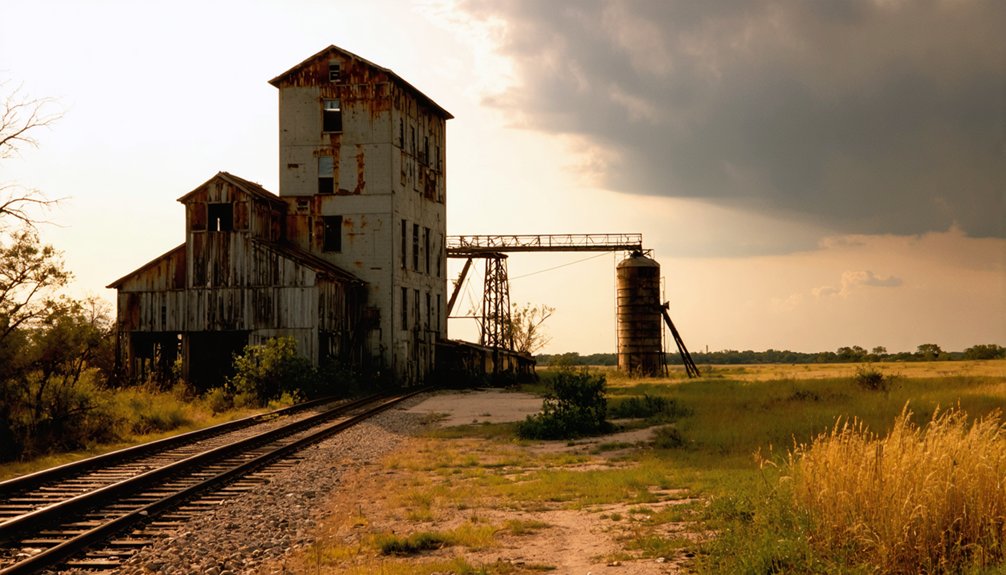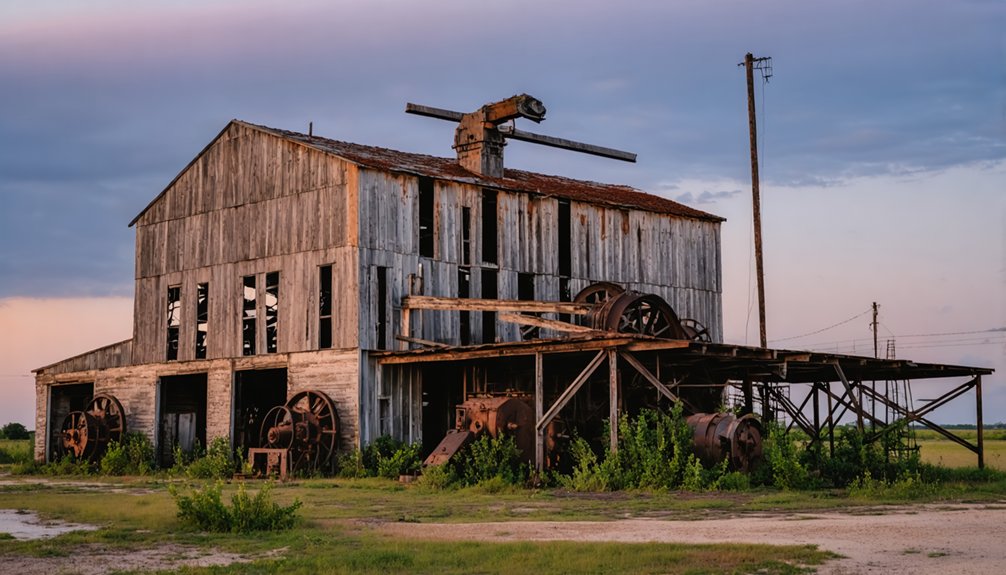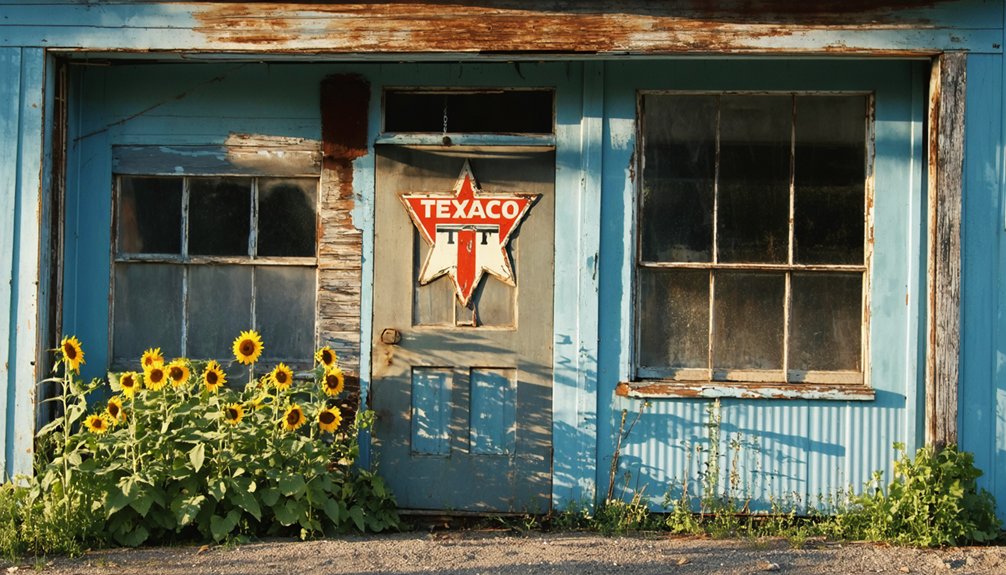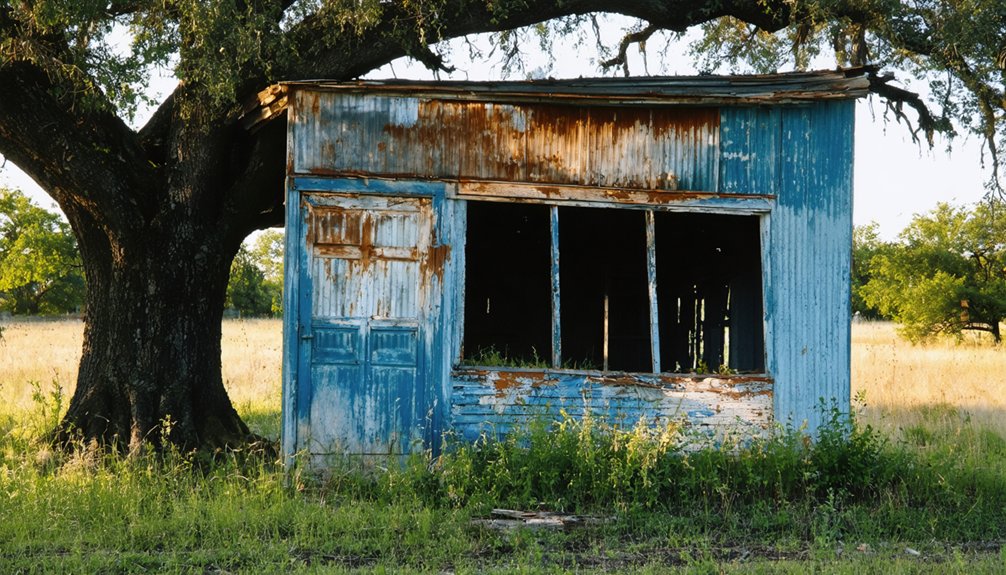You’ll find Goforth, Texas as a ghost town that once thrived as a cotton farming community in the 1870s. Founded by J.T. Goforth, it featured a general store, post office, and the Prairie Hill School that served local German immigrants. The town prospered until natural disasters, including the devastating 1913 flood and 1926 cotton worm infestation, sparked its decline. The cemetery and scattered remnants hold fascinating tales of this lost agricultural empire.
Key Takeaways
- Goforth was established in the 1870s as an agricultural community centered on cotton production before transitioning to a ghost town.
- The community’s decline began after natural disasters, including a devastating 1913 flood and 1926 cotton worm infestation.
- The Goforth Store, which served as the community hub, closed in 1926, marking a significant milestone in the town’s decline.
- Historical remnants include the Prairie Hill School, St. John’s Lutheran Church, and a cemetery containing early settler graves.
- The settlement’s agricultural economy collapsed during the Great Depression, leading to population loss and eventual ghost town status.
The Rise of a Cotton Empire
While Spanish missionaries first introduced cotton cultivation to Texas in the early 18th century, it wasn’t until Anglo-American colonists arrived in 1821 that the crop’s true potential emerged.
Settlers from Louisiana and Alabama brought their cotton-growing expertise and slave labor, establishing thriving plantations near San Felipe de Austin. By 1849, you’d find Texas ranking eighth nationally with 58,073 bales produced.
Cotton-savvy settlers from Louisiana and Alabama established lucrative plantations using slave labor, propelling Texas into a top cotton producer by mid-century.
The agricultural expansion surged as Native American removal opened new lands in the 1850s. The introduction of barbed wire and railroads in the 1870s further stimulated the industry’s growth. In this environment, J.T. Goforth seized the opportunity to establish his namesake town in eastern Hays County during the 1870s.
His gin and milling operation became one of the region’s largest, capitalizing on the fertile bottomlands. His success was further enhanced when a post office opened in 1890. You can trace Goforth’s meteoric rise as a cotton hub through its strategic location and industrial capacity.
J.T. Goforth’s Legacy and Vision
You’ll find J.T. Goforth’s pioneering spirit reflected in his 1870s establishment of the Goforth settlement, where he opened a general store that served as both a commercial and social hub for local farming families.
As the community’s first postmaster and owner of one of the largest cotton gins in the area, he strategically developed essential infrastructure despite the town’s isolation from major rail lines. In 1894, J.M. Butterworth took over the store operations but only maintained them for three years. The town’s name required proper disambiguation due to multiple locations sharing the Goforth title.
His vision for a self-sufficient agricultural center materialized through the addition of diverse services, including a drugstore, doctor’s office, meat market, stable, and blacksmith shop during the settlement’s peak years.
Founding Father’s Early Vision
In the 1870s, James Taylor Goforth established a community that would bear his name, driven by his vision of creating a self-sustaining rural commercial hub.
Despite settler challenges, he built a general store that became both an economic engine and social gathering place for the growing community. You’ll find his influence embedded in every aspect of early development, from supporting cotton farmers with essential supplies to fostering agricultural innovations through merchant services. Like modern genealogical record collections, Goforth’s store served as a vital hub for preserving local family histories and connections. His commitment to the area was further demonstrated through his role as justice of the peace for many years.
Goforth’s vision extended beyond commerce – he understood the importance of education and communication.
Community and Business Leadership
As Goforth’s community took root, J.T. Goforth’s entrepreneurial spirit transformed the settlement into a thriving agricultural hub.
You’ll find his influence everywhere – from establishing the post office in 1890 to running the general store that served as the town’s financial and social center. His community engagement extended beyond commerce, as he built a network of essential services including a drugstore, doctor’s office, and blacksmith shop. Like the extensive genealogical records that trace family histories, his legacy is documented throughout the region’s courthouses and archives.
You can trace his impact through the establishment of one of the region’s largest cotton gins, which bolstered local cotton production and made Goforth a key agricultural center in Hays County. Similar to how C.D. Goforth expanded farming operations during difficult economic times, J.T. Goforth’s business ventures helped sustain the local agricultural economy.
While he believed strongly in self-reliance over handouts, his business ventures created a self-sufficient infrastructure that supported local farmers and residents until environmental challenges in the 1920s began to impact crop yields.
Daily Life in Early Goforth
In early Goforth, you’d find local farmers and their families gathering regularly at the community store to exchange news and supplies while taking breaks from their cotton farming duties.
Your typical day as a farming family would revolve around seasonal cotton production, with dawn-to-dusk fieldwork punctuated by shared meals and essential household chores. The town prospered in the early 1900s when cotton production reached its peak.
The community’s social fabric strengthened through these daily interactions at local gathering spots, where you could catch up on local happenings while conducting necessary business. Many residents relied on the Goforth ginning company for processing their cotton harvests, making it a vital hub of economic activity.
Social Gatherings at Store
The Goforth Store served as more than just a merchant establishment – it was the beating heart of social life in early Goforth, Texas.
You’d find farmers and ranchers engaging in store interactions throughout the day, sharing crop information and catching up on local news. The space naturally evolved into a hub for community gatherings, where scattered settlers could maintain their connections despite rural isolation.
As both a general store and unofficial bank, it drew diverse patrons including Anglo settlers and Mexican American families. You could handle your banking needs, collect mail, or simply enjoy casual conversations with neighbors.
The store’s role as a social anchor lasted from the 1870s through 1926, when soil erosion and ecological challenges led to its closure, marking the end of an era in Goforth’s communal life.
Farm Family Routines
Life on a Goforth farm meant dawn-to-dusk labor for every family member, with daily routines centered around cotton cultivation and essential homestead maintenance.
You’d find yourself constantly tending to farm chores – gathering water from wells, chopping firewood, and mending fences to protect your livestock and crops. While parents worked the cotton fields, children pitched in with family labor, collecting eggs and helping with seasonal planting and harvesting.
The women’s day revolved around intensive household tasks, including hand-washing laundry with washboards and preparing meals from scratch using home-preserved foods.
You’d preserve your harvest through canning vegetables and smoking meats to sustain your family between growing seasons. Multi-generational households shared the workload, with everyone’s efforts focused on keeping the farm productive despite challenges like soil erosion and flooding.
The Prairie Hill School Years
Prairie Hill School emerged as a cornerstone of Goforth’s early development when local community members constructed its first building in 1881.
You’ll find that Prairie Hill’s education system served the area’s German immigrant families who’d settled there in the 1870s, working alongside St. John’s Lutheran Church to shape the community’s cultural identity.
The school’s influence grew considerably through the years, adapting to the changing needs of Washington County.
By 1953, you’d have witnessed the merger with Mound Hill School District, reflecting the broader trend of rural school consolidation across Texas.
The school’s deep connection with St. John’s Lutheran Church, which had grown to over 450 members, created a tight-knit educational and social environment that defined Goforth’s community spirit for generations.
Agricultural Glory Days

Beyond the schoolhouse doors lay Goforth’s agricultural heartland, anchored by Church Goforth’s 460-acre farm established in 1888.
You’ll find his agricultural techniques maximized the fertile bottomlands along White Rock Creek, where cotton fields stretched across the landscape. His crop diversification strategy included both cotton farming and cattle ranching, protecting against market volatility.
Strategic crop diversification and fertile creek bottomlands created an agricultural empire spanning cotton fields and cattle pastures.
You’d have witnessed Goforth become one of the region’s premier cotton production centers, with farmers leveraging northern market connections for both crops and cattle. The rich soil yielded prosperity that built schools and supported community traditions like the Goforth Family BBQ.
However, by 1913, flooding began eroding the soil, and a devastating worm infestation in 1926 spelled the end of cotton farming, accelerating the town’s decline toward ghost status.
Natural Disasters and Environmental Impact
You’ll find that Goforth’s decline began with the devastating flood of 1913, which destroyed much of the town’s agricultural infrastructure and washed away critical farming equipment.
The flood’s impact was immediately compounded by a severe cotton worm infestation that ravaged the remaining crops, leaving farmers with mounting debts and diminishing hopes.
These twin environmental disasters struck at the heart of Goforth’s cotton-based economy, forcing many residents to abandon their land and seek opportunities elsewhere.
Devastating 1913 Flood Impact
The devastating Great Flood of 1913 brought unprecedented destruction to Goforth and much of central Texas between March 23-26, permanently altering the region’s landscape and future.
You’ll find that the flood aftermath was particularly severe in the Brazos River basin, causing over $3.5 million in damage and claiming 177 lives. The disaster released not just flooding but also tornadoes, hail, and sleet across the region.
Despite attempts at community resilience, the flood accelerated Goforth’s decline by washing away valuable farmland and destroying essential crops.
The area’s agricultural base, primarily cotton farming, never fully recovered. The catastrophe’s long-term effects hastened population loss, eventually leading to the school’s closure in 1948.
Today, only the cemetery and historical markers remain to tell Goforth’s story.
Cotton Worm Infestation Crisis
While Goforth’s farming community had already faced significant challenges, a devastating cotton worm infestation in 1926 delivered the final blow to this once-thriving agricultural center.
The cotton pest management methods available at the time proved woefully inadequate against the destructive bollworms, which ravaged crops by feeding on leaves, buds, and cotton bolls.
You’ll find that the community’s agricultural resilience had already been weakened by severe soil erosion and exhausted farmland, making the cotton particularly vulnerable to pest attacks.
The infestation’s impact was swift and merciless – farmers abandoned their fields, and the local supply company shut its doors, leaving shelves of unused inventory behind.
This crisis, combined with deteriorating environmental conditions, accelerated Goforth’s transformation into a ghost town.
The Great Cotton Crisis

During Goforth’s prosperous years as a cotton hub in Hays County, few could have predicted the devastating crisis that would ultimately lead to its demise.
The cotton economy faced multiple challenges: severe soil erosion depleted farmland fertility by 1925, while a destructive worm infestation in 1926 forced many farmers to abandon their fields.
Labor shortages intensified as Mexican workers, who’d provided essential low-wage labor, became scarcer.
The Great Depression delivered another blow, crushing cotton prices and demand.
Federal programs in the late 1920s and 1930s complicated matters by mandating reduced cotton acreage.
Meanwhile, foreign competition and the rise of synthetic fibers eroded market share.
These combined pressures transformed Goforth from a thriving agricultural center into a ghost town by the decade’s end.
Remnants of a Bygone Era
Today, visiting Goforth reveals scant evidence of its once-thriving cotton economy, with only a weathered cemetery and scattered structural remnants marking its existence.
You’ll find rusted iron fencing surrounding the burial grounds, where forgotten memories lie beneath unmarked graves of early settlers. Time and nature have reclaimed most of the townsite, with soil erosion burying what’s left of wooden structures and metal debris.
The site’s historical markers are clearly absent – no preserved storefronts, cotton gin equipment, or Prairie Hill school building remain after its closure in 1948.
You won’t find maintained trails or interpretive centers, just open land where buildings once stood. The 1913 flood and subsequent highway construction have left Goforth isolated, its physical traces slowly fading into Texas’s ghostly past.
Preserving Local Heritage

Despite Goforth’s physical decline, dedicated community efforts guarantee its legacy endures through organized preservation initiatives. Through active community engagement, you’ll find local residents and historical societies working together to protect this slice of Texas history.
The commitment to historical preservation spans multiple approaches:
- Regular volunteer clean-ups maintain the site while educational programs in nearby schools assure younger generations understand Goforth’s significance.
- Documentation efforts capture oral histories from descendants, while archivists digitize fragile records and photographs for future access.
- Heritage tourism development includes interpretive trails and strategic promotion alongside other Texas Hill Country ghost towns.
You’ll also notice careful zoning regulations and preservation codes that protect the site from unsanctioned development, assuring Goforth’s story remains intact for future explorers.
Martin Church: A Lasting Testament
Among Goforth’s most enduring landmarks, Martin Church stands as a symbol of the community’s pioneer spirit and religious heritage. Founded in 1874, this historic church served cotton-producing settlers as both a spiritual center and social hub, marking its significance in early Texas pioneer life.
You’ll find the church about 4.5 miles east of Buda near County Road 157, where it received its historical marker in 1981. Though the congregation’s no longer active, the church’s legacy lives on through the nearby Martin Cemetery, where the graves of William Martin, his wife Rutha, and other early settlers rest beneath cedar trees.
The church’s lasting tribute to community legacy reflects the determination of Goforth’s pioneers, even as their once-thriving settlement faded into a ghost town by the 1920s.
Frequently Asked Questions
What Happened to J.T. Goforth’s Descendants After the Town’s Decline?
You’ll find that family legacy records don’t specify their exact fate, but descendant stories suggest they scattered to growing Texas cities and farms after the 1913 flood and economic decline.
Were There Any Notable Crimes or Lawless Incidents in Goforth?
You won’t find documented crime incidents or significant law enforcement activity in the historical records. While minor disputes likely occurred, there’s no evidence of notable lawlessness in this rural community.
What Native American Tribes Originally Inhabited the Goforth Area?
You’ll find that four major tribes controlled this land: the Comanches dominated after 1700, while Tonkawas, Lipan Apaches, and Coahuiltecans shared the area’s rich tribal history and cultural significance beforehand.
Did Any Famous People Ever Visit or Pass Through Goforth?
You won’t find any documented celebrity sightings or historical visitors in this town’s records. The area’s local focus and small population didn’t attract famous figures throughout its inhabited history.
What Transportation Methods Did Early Goforth Residents Use Before Automobiles?
You’d have found early residents traveling by horse-drawn carriages, wagons, and on horseback. Once rail transportation arrived, they’d take trains to reach nearby cities and transport goods.
References
- https://texashistoricalmarkers.weebly.com/goforth.html
- https://en.wikipedia.org/wiki/Goforth
- https://www.texasescapes.com/TexasHillCountryTowns/Goforth-Texas.htm
- https://www.ghosttowns.com/states/tx/goforth.html
- https://en.wikipedia.org/wiki/List_of_ghost_towns_in_Texas
- https://www.wikiwand.com/en/articles/Goforth
- https://texashillcountry.com/hill-country-ghost-towns-explore/
- https://www.allacrosstexas.com/texas-ghost-town.php?city=Goforth
- https://www.youtube.com/watch?v=DpykTZIMQsA
- https://services.austintexas.gov/edims/document.cfm?id=307020



